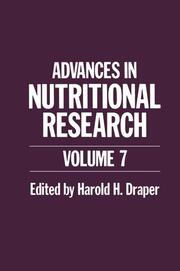-
Zusatztext
-
Volume 7 of Advances in Nutritional Research continues the theme of this series in providing authoritative accounts of the current state of knowledge regarding major topics of research in the nutritional sciences. The topics have been selected for their interest to researchers, students, and teachers in medicine, agriculture, and the various branches of the biological sciences which relate to nutritional health. The authenticity of the accounts is assured by the widely recognized contributions of the authors to research on their respective topics. vii Contents 1 Chapter 1. Food Allergy. David J. Pearson and Alison McKee 1. Introduction. 1.1. General Introduction. 1.2. Classification of Adverse Reactions to Foods. 2 1.3. Classification and Time Course of Allergic Reactions. 4 2. The Atopic Syndrome. 5 2.1. Atopy. 5 2.2. IgE (Reaginic) Antibodies. 6. 3. The Diagnosis of Food Allergy. 8 3.1. Provocative Feeding Tests. 8 3.2. Skin Tests. 10 3.3. Measurement of Specific Antibodies 10 3.3.1. IgE Antibodies. 10 3.3.2. Non-IgE Antibodies. 11 3.4. Controversial Techniques. 11 3.5. Summary of Diagnostic Procedures. 12 4. Clinical Food Allergic Syndromes. 13. 4.1. Classical Reaginic Syndromes. 13. 4.1.1. Presenting Complaints. 13 4.1.2. Frequency. 13.
-
-
Autorenportrait
- Inhaltsangabe1. Food Allergy.- 1. Introduction.- 1.1. General Introduction.- 1.2. Classification of Adverse Reactions to Foods.- 1.3. Classification and Time Course of Allergic Reactions.- 2. The Atopic Syndrome.- 2.1. Atopy.- 2.2. IgE (Reaginic) Antibodies.- 3. The Diagnosis of Food Allergy.- 3.1. Provocative Feeding Tests.- 3.2. Skin Tests.- 3.3. Measurement of Specific Antibodies.- 3.3.1. IgE Antibodies.- 3.3.2. Non-IgE Antibodies.- 3.4. Controversial Techniques.- 3.5. Summary of Diagnostic Procedures.- 4. Clinical Food Allergic Syndromes.- 4.1. Classical Reaginic Syndromes.- 4.1.1. Presenting Complaints.- 4.1.2. Frequency.- 4.1.3. Symptom Patterns.- 4.1.4. Time Course of Symptoms.- 4.1.5. Commonly Incriminated Foods.- 4.2. Eczema (Atopic Dermatitis).- 4.2.1. Food Hypersensitivity in Eczema.- 4.2.2. Mechanism.- 4.2.3. Influence of Breast-Feeding.- 4.3. Food-Induced Gastroenteropathies.- 4.3.1. Coeliac Disease.- 4.3.2. Milk-Sensitive Enteropathy.- 4.3.3. Eosinophilic Gastroenteritis.- 4.4. Other Putative Food-Allergic Disorders.- 4.4.1. Heiner and Sudden Infant Death Syndromes.- 4.4.2. Arthritis.- 4.4.3. Migraine.- 4.4.4. Neurologic and Psychiatric Syndromes.- 5. Anaphylactoid Reactions.- 5.1. Introduction.- 5.2. Salicylates, Benzoates, and Azo Dyes.- 5.3. Sulfur Dioxide and Metabisulfites.- 5.4. Histamine and Non-Specific Histamine Release.- 5.5. Alcohol.- References.- 2. The Dietary Management of Diabetes.- 1. Introduction.- 2. How Much Carbohydrate?.- 2.1. Historical.- 2.2. Effects of Fiber and Carbohydrate on Indices of Diabetic Control.- 2.2.1. Experiments Predominantly with Fiber.- 2.2.2. Test Meal Studies.- 2.2.3. Longer Term Studies.- 2.2.4. Experiments Predominantly with Carbohydrate.- 2.2.5. Variations in Quantity.- 2.2.6. Variations in Source.- 2.2.7. Mixed Diet Studies.- 2.3. Mechanisms of Action of Carbohydrate and Fiber.- 3. Cholesterol.- 3.1. Effect of Purified Fiber on Cholesterol Levels.- 3.2. Effect of Carbohydrate and Fiber on Cholesterol Levels.- 3.3. Dietary Effects on HDL Cholesterol.- 4. High Carbohydrate Diet and Triglycerides.- 5. Diabetic Diets - The Patient's Point of View.- 6. Conclusions.- References.- 3. Cognitive Effects of Nutritional Deficiency.- 1. Introduction.- 2. Childhood Malnutrition.- 3. Malnutrition in Adulthood.- 4. Vitamin Deficiencies Strongly Associated with Cognitive Impairment.- 4.1. Vitamin B12 and Pernicious Anemia.- 4.2. Niacin, Pellagra, and the Role of Tryptophan.- 4.3. Thiamine.- 5. Vitamin Deficiencies Possibly Associated with Cognitive Impairment.- 5.1. Folate.- 5.2. Vitamin C.- 5.3. Multiple Vitamin Deficiency.- 6. "Pharmaco-Nutrition".- 7. Summary.- 8. Acknowledgement.- References.- 4. Nutritional Assessment of Observed Nutrient Intake: An Interpretation of Recent Requirement Reports.- 1. Introduction.- 2. Human Nutrient Requirements: Understanding and Interpretation.- 2.1. The Meaning of Requirement.- 2.2. Variation of Requirements.- 3. Probability Approach to Interpretation of Nutrient Intake.- 4. Interpretation of Energy Intake.- 5. Estimation of Usual Intake.- 5.1. Time Frame of Requirement Estimates.- 5.2. Day-to-Day Variation in Intake: Implications for Design and Interpretation.- 6. Evaluation of Diet Quality: Nutrient Density or Nutrient-Energy Ratios.- 7. Examination of Population Data: Estimation of Prevalence of Inadequacy or Population Risk.- 7.1. Application of Probability Statistics to a Population.- 7.2. Intraindividual Variability in Population Data.- 8. Conclusions.- References.- 5. The Role of Ethanol in the Etiology of Primary Liver Cancer.- 1. Introduction.- 2. Experimental Carcinogenesis Modeling.- 3. Carcinogenicity Initiation.- 4. Drug Metabolism.- 5. Cirrhosis.- 6. DNA Metabolism.- 7. Nutritional Status.- 8. Membrane Stability and Integrity.- 9. Other Mechanisms.- 10. Animal Experimentation.- 11. Conclusion.- 12. Acknowledgement.- References.- 6. Animal Models for the Study of Nutrition and Human Disease: Colon Cancer, Atherosclerosis, and Osteoporosis.- I.
Detailansicht
Advances in Nutritional Research
Volume 7, Advances in Nutritional Research 7
ISBN/EAN: 9781461295273
Umbreit-Nr.: 5657054
Sprache:
Englisch
Umfang: 290 S.
Format in cm:
Einband:
kartoniertes Buch
Erschienen am 26.09.2011
Auflage: 1/1985


